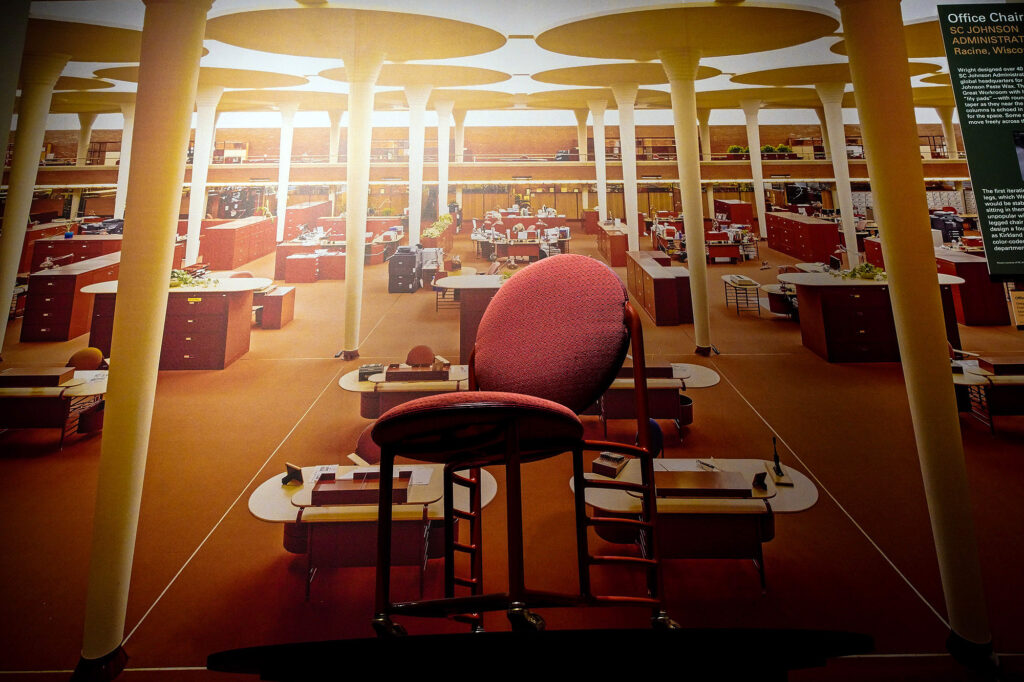There’s lots of inspiration to be had at the Kirkland Museum in Denver: paintings, sculpture, among a host of other items, to be sure. But the gift of a lamp is what inspired a new exhibition with a familiar name attached.
“Frank Lloyd Wright Inside the Walls” illuminates the relationship between Wright’s architecture — what he’s best known for — and his decorative art, including that lamp.
Around a dozen of Wright’s building projects, including the Imperial Hotel (Tokyo)the Price Tower (Oklahoma)and the Austin House (South Carolina) are represented in the Kirkland Museum’s permanent collection of decorative art objects. But it was the story of the lamp that sparked the idea for this unique exhibit.
The lamp, however, didn’t start out as a lamp, but rather as two separate works of glass art. Frank Lloyd Wright glass expert Julie Sloan recognized the art glass pieces as his designs. She learned that Wright had exhibited them as part of his 1907 exhibition at the Art Institute of Chicago. For years after, they fell off the art world radar.
Then in 1964, art collector Lewis Newman’s mother, Bertie Slutzky, found the pieces in an antique store in Chicago.
“She recognized that these were Wright. She was a fan of his — a Wright enthusiast, I guess,” said exhibit co-curator Christopher Herron. “And she took the pieces to a local metalsmith and had them made into a lamp.”
 Hart Van Denburg/CPR News
Hart Van Denburg/CPR News Hart Van Denburg/CPR News
Hart Van Denburg/CPR NewsThe lamp ended up with Newman, who displayed the lamp in his own window for years after receiving it as a graduation present from his mother.
“He tells this story of how he lived in a New York city apartment and he had this lamp in the window and it kind of just glowed and people could see it from the street,” said exhibit co-curator Becca Goodrum. “So it was kind of on public view, but not really, but you could see it in their window, which I think is a really cute story.”
In 2018, Newman and his husband gave it to Kirkland Museum’s founding director, Hugh Grant, for his collection.
Another highlight in the exhibit is an office chair Wright designed for the SC Johnson family company headquarters in Racine, Wisconsin, a building that he also designed. The display showcases not only Wright’s “total work of art” — or gesamtkunstwerk — approach, but also how even he could revise his pieces when faced with practical concerns.
“The curator that we talked to at the SC Johnson company called it a problematic piece of furniture because it had three legs.’ Goodrum said. “He wanted this chair to force you to have good posture. And you did have to sit perfectly and really not move a muscle in order to not tip over. He got a lot of complaints, but he was reticent to change the design … until one day he fell out of a chair. And he finally was like, ‘Oh, all right people, I guess you’re right. I will redesign the chair to give it four legs,’ like our example at Kirkland museum.”
The kind of branding common for “lifestyle” brands and designers today also has a through line to Frank Llloyd Wright’s work. Color was such a critical component of his work, that Wright teamed with the Martin Senour Paints company in 1955. And that wasn’t all.
 Hart Van Denburg/CPR News
Hart Van Denburg/CPR News Hart Van Denburg/CPR News
Hart Van Denburg/CPR News“He worked with the heritage Hendon furniture company at the same time, producing a mass produced line of his own furniture,” Herron said. “So the idea was, I guess you could create your own Wright environment or Wright-inspired environment in your home. And the paints that we used came from some of his original Martin Senour Paint palettes that we were able to track down. So the greens and the golds of the early arts and crafts give way to … what he called Cherokee red floors of the later work.”
The most well-known American architect of our time, Frank Lloyd Wright built interior furnishings and accessories as part of his concept of a complete work of art, in addition to the famous buildings for which he is best known. And at the Kirkland Museum exhibit, Wright’s furniture, dinnerware, and art glass are all on display in their original settings, providing insight into Wright’s unified vision of a total work of art.
“Frank Lloyd Wright Inside The Walls,” runs at the Kirkland Museum of Fine and Decorative Art in Denver through January 8, 2023.